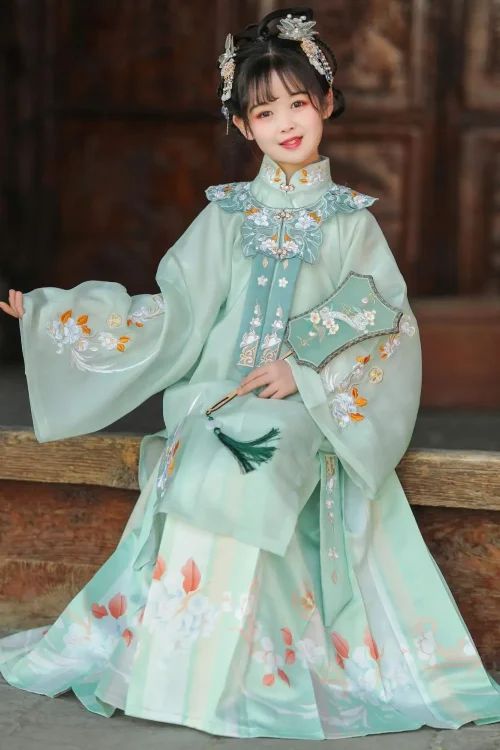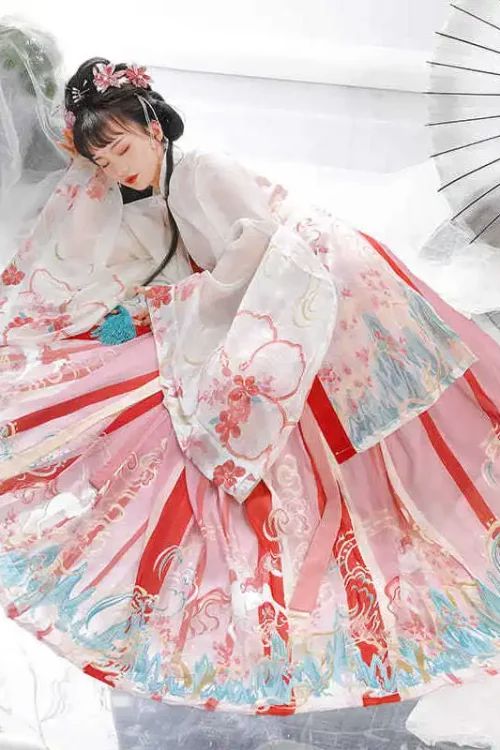The Phoenix and Dragon: Symbols of Imperial Power and Harmony
In the tapestry of Chinese history, the Ming Dynasty stands out as an era of cultural and artistic brilliance. Among its many contributions, the exquisite Hanfu garments worn during this period hold a special significance, adorned with intricate designs and vibrant colors that whispered tales of power, harmony, and the celestial realm.

The Symbolism of the Phoenix
The phoenix, a mythical bird revered as the empress of all creatures, was a prominent motif in Ming Hanfu. Its graceful form, adorned with vibrant hues of red, gold, and green, symbolized the empress’s virtue, beauty, and authority.
The Dragon’s Representation
The dragon, a symbol of the emperor, was equally prevalent, its serpentine body and sharp claws representing strength, wisdom, and the mandate of heaven. Together, the phoenix and dragon formed a harmonious pair, embodying the balance between yin and yang and the unity of the imperial court.
Other Auspicious Symbols
Beyond these celestial creatures, other auspicious symbols graced Ming Hanfu. The crane, with its long lifespan, represented longevity and good fortune. The peony, with its opulent blooms, symbolized wealth and prosperity. The lotus, emerging from murky waters, embodied purity and enlightenment. Each design carried a specific meaning, woven into the fabric to convey the wearer’s aspirations and beliefs.
The Significance of Colors
The colors used in Ming Hanfu were equally symbolic. Red, the color of fire and passion, was reserved for the emperor and his family. Yellow, the color of the sun, represented imperial authority and was worn by high-ranking officials. Blue, the color of the sky, symbolized peace and tranquility. Green, the color of nature, represented growth and prosperity.
A Visual Symphony
The combination of these designs and colors created a visual symphony that reflected the Ming Dynasty’s cultural and political landscape. The phoenix and dragon, symbols of imperial power and harmony, adorned the garments of the ruling elite. Auspicious symbols, such as the crane and peony, conveyed the hopes and aspirations of the people. And the vibrant colors, each with its own significance, painted a vivid tapestry of the Ming Dynasty’s grandeur and sophistication.
Conclusion
In conclusion, the designs and colors of Ming Dynasty Hanfu were not merely decorative elements but profound expressions of the era’s beliefs, values, and aspirations. Through these intricate patterns and vibrant hues, the Ming people wove a rich tapestry that continues to captivate and inspire generations to come.
The Lotus and Peony: Flowers of Purity and Prosperity
In the tapestry of Chinese history, the Ming Dynasty stands out as an era of cultural and artistic brilliance. Among its many contributions, the exquisite Hanfu garments worn during this period hold a special significance, adorned with intricate designs and vibrant colors that carry profound symbolic meanings.

The Symbolism of the Lotus
The lotus flower, a symbol of purity and enlightenment, frequently graced Ming Hanfu. Its delicate petals, often depicted in shades of pink or white, represented the wearer’s aspiration for spiritual growth and moral integrity.
The Peony’s Significance
The peony, on the other hand, symbolized prosperity and good fortune. Its lush blooms, rendered in vibrant hues of red or purple, adorned the garments of those seeking wealth and success.
The Importance of Color
Beyond these floral motifs, the colors themselves held deep significance. Red, the color of fire and passion, was reserved for auspicious occasions and worn by high-ranking officials. Yellow, the imperial color, represented the emperor’s authority and was strictly forbidden for commoners. Blue, associated with the sky and water, symbolized tranquility and harmony. Green, the color of nature, represented growth and vitality.
Design Placement
The placement of these designs and colors was also carefully considered. The front of the Hanfu often featured auspicious symbols, such as dragons or phoenixes, to ward off evil spirits. The back, on the other hand, was adorned with more personal motifs, such as flowers or birds, to express the wearer’s individuality.
A Visual Language
The symbolism behind Ming Dynasty Hanfu designs and colors extended beyond aesthetics. They served as a visual language, conveying the wearer’s social status, aspirations, and beliefs. By deciphering these symbols, we gain a deeper understanding of the cultural and social fabric of this remarkable era.
Conclusion
In conclusion, the intricate designs and vibrant colors of Ming Dynasty Hanfu garments were not merely decorative elements. They carried profound symbolic meanings, reflecting the wearer’s hopes, dreams, and aspirations. By unraveling these symbols, we not only appreciate the beauty of these garments but also gain a glimpse into the rich cultural heritage of China’s past.
The Colors of Hanfu: A Reflection of the Ming Dynasty’s Cultural Values
The Ming Dynasty (1368-1644) witnessed a resurgence of traditional Chinese culture, including the revival of Hanfu, the traditional clothing of the Han Chinese. Hanfu designs and colors during this period were imbued with profound symbolism, reflecting the cultural values and beliefs of the time.

Meaning of Colors
The colors of Hanfu were carefully chosen to convey specific meanings. Red, the most auspicious color, represented joy, prosperity, and good fortune. It was often used for ceremonial occasions, such as weddings and festivals. Yellow, the color of the emperor, symbolized power and authority. It was reserved for the imperial family and high-ranking officials. Blue, associated with the sky and water, represented tranquility and harmony. It was a popular choice for everyday wear.
Significant Designs
The designs on Hanfu were equally significant. Dragons, a symbol of imperial power and strength, were often embroidered on the robes of emperors and high-ranking officials. Phoenixes, representing beauty and grace, were commonly found on the clothing of women. Cranes, symbolizing longevity and wisdom, were often depicted on the robes of scholars and elders.
Placement of Designs
The placement of these designs was also carefully considered. Dragons were typically embroidered on the chest or back, while phoenixes were placed on the sleeves or skirt. Cranes were often found on the shoulders or cuffs. This arrangement reflected the hierarchical order of the Ming society, with the emperor at the top and the common people at the bottom.
Practical Purposes
In addition to their symbolic meanings, Hanfu designs and colors also served practical purposes. The loose-fitting robes allowed for freedom of movement, making them suitable for everyday activities. The use of natural fibers, such as silk and cotton, provided comfort and breathability.
Cultural Insights
The symbolism behind Ming Dynasty Hanfu designs and colors offers a glimpse into the cultural values and beliefs of the time. These vêtements were not merely clothing but also a reflection of the social hierarchy, religious beliefs, and aesthetic sensibilities of the Ming people. By understanding the symbolism behind these designs and colors, we can gain a deeper appreciation for the rich cultural heritage of China.
